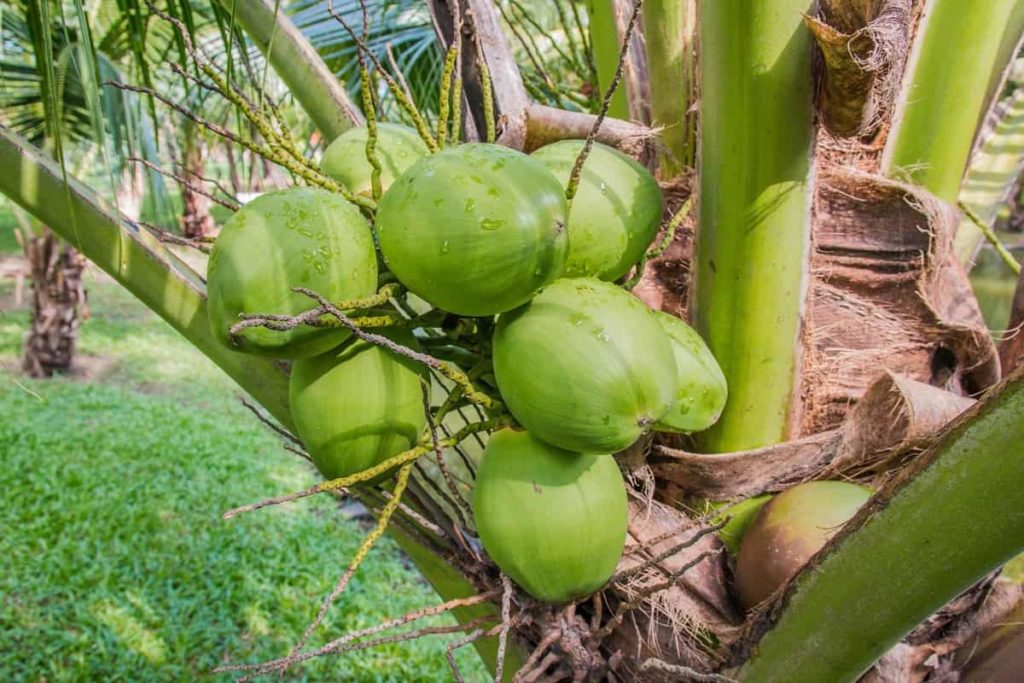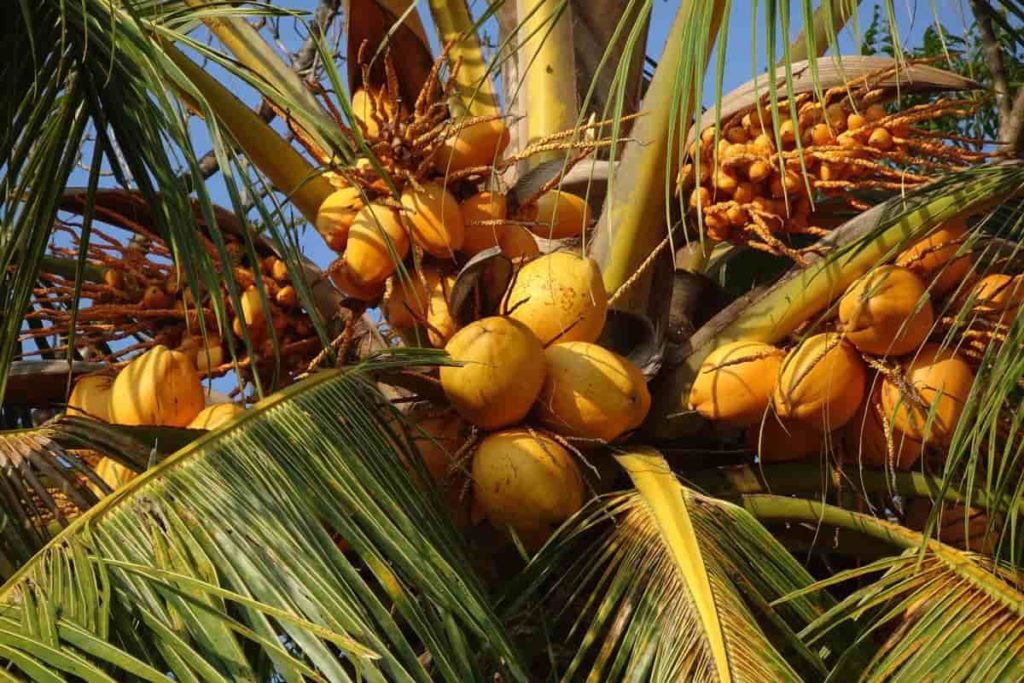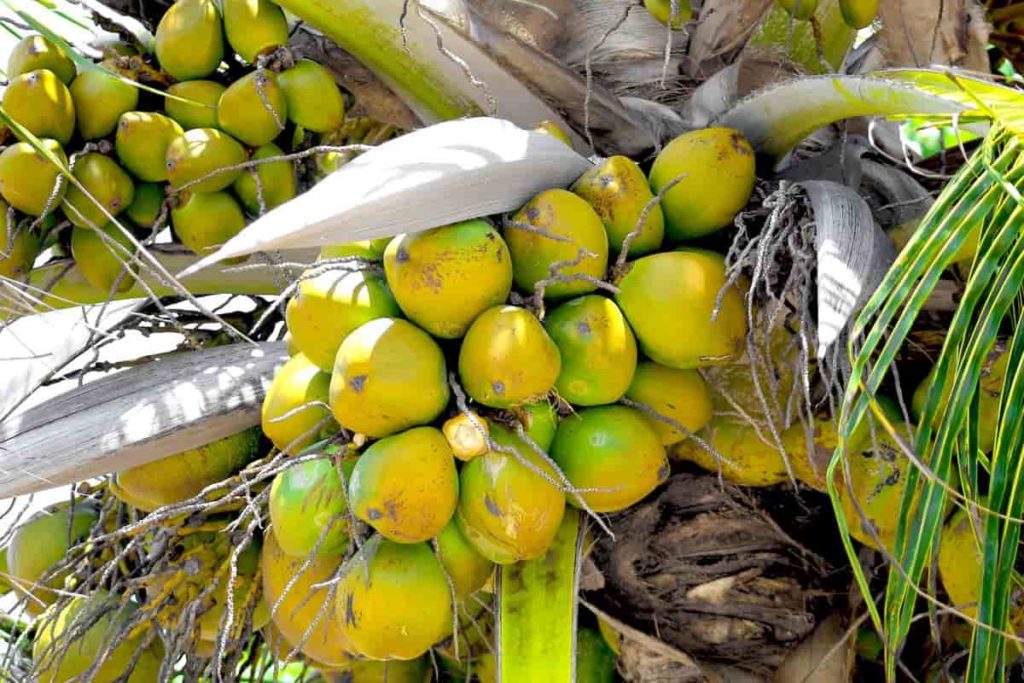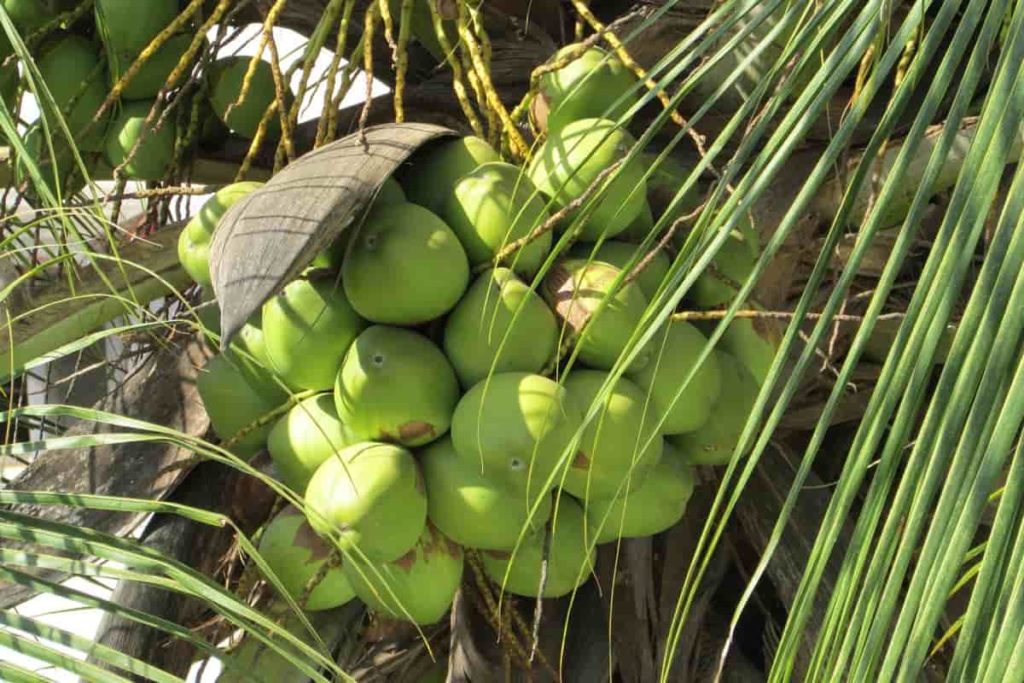If you have access to a fresh Coconut, you might think that growing a Coconut plant would be fun, and you would be right. Growing a Coconut palm tree is easy and fun. Coconut trees are beautiful plants that produce delicious fruits. Whether you plan to grow your Coconut tree outdoors or as a house plant, it’s a simple process that will create an attractive addition to any yard or house.

When it grows easily from a fresh Coconut, you should be patient and wait six months or more for it to germinate. The plant grows faster and will present you with Coconuts in about six to ten years. The Coconut palm plant is characterized by a tall, greyish brown, slightly curved single trunk, sprawling green palm fronds, and Coconuts. It also likes a lot of heat, sun, and humidity.
How to grow Coconut from seed to harvest
How long does Coconut take to grow from seed?
- These are widely planted for household and commercial use and grow to 20 to 30 meters. They are gradually maturing and flowering 6 to 10 years after planting. Coconuts are long-lived, with an economic life of about 60 to 70 years, although old palms exist and are known to yield well.
- Although it takes patience before your Coconut palm starts bearing fruit, they grow faster than your typical tree. When grown from seeds, you can expect your Coconut palm to start producing fruit in 6 to 10 years, but it won’t reach much yield until about 15 to 20 years after planting.
- This tree grows from a seed, which is a whole Coconut, which takes 5 to 8 years to bear fruit and lasts between 60 and 100 years. Each Coconut tree takes about a year to grow from flower to fruit.
- These small flowers produce fruits, which after about nine months, become fully formed Coconuts. The ideal harvest time is about 7.5 months after the flower blooms. The Coconuts fall to the ground once they are fully ripe.
How do you grow a Coconut from seed?
- Select the fallen nut you hear while shaking the water slush to choose a Coconut to grow.
- Keep your seed Coconut in a bucket of lukewarm water for 3 to 4 days to soften it. After the Coconut softens, place it in a re-sealed plastic bag with a cup of water and store it in a hot, dark place until it sprouts and roots grow.
- You should soak it in water for two to three days. After soaking the Coconut, you can place it in a container filled with well-draining potting soil. The container needs to be about 12 inches.
- With proper care, a Coconut will grow in 3 to 6 months. The roots of a growing Coconut are pushing through the husk, and a sharp shoot is also emerging from the bottom of the nut.
- Coconut seed grows slowly; it takes up to 6 months for the shoot to appear. During germination, a single cotyledon produces within the depth of the seed. After two weeks, it hardens and starts forming the first root on the undersides, followed by an upward shoot.
In case you missed it: 14 Common Coconut Tree Problems: How to Fix Them, Solutions, and Treatment

How many Coconuts can one tree produce?
- Due to several factors, production varies from region to region. A tree can give an average of 70 to 100 nuts to a maximum of 150 nuts annually.
- With proper care, a Coconut palm tree will produce 50 to 200 fruits annually for 80 years, so learning how to fertilize Coconut palm trees is paramount for tree longevity.
- A tall Coconut palm tree can yield 75 fruits annually on fertile soil but often yields less than 30. Given proper care and growing conditions, Coconut palms produce their first fruit in six to ten years, and it takes 15 to 20 years to reach higher yields.
How many times can Coconut be harvested in a year?
- On average, you can take up to eight harvests, although Coconut palm produces inflorescence every month.
- The Coconut palm is one of the world’s most useful and famous trees, thanks to its fruit. Unlike most fruit-bearing plants, mature Coconut trees produce their fruits throughout the year rather than in a specific season. The weight of the husk from the nuts should not be less than 600 grams, and the copra content should be around 150 grams.
- It can be harvested with a Coconut palm every month. Farmers usually get two to three bunches from each tree for affordability. This occurs in each harvest cycle between 45 to 60 or 75 to 90 days. On average, you can collect 10 to 45 fruits from each Coconut tree at different maturity stages in each harvest cycle.
How much water do Coconut trees need?
- Coconut trees require 15 to 30 gallons of water per day if grown for fruit harvesting purposes. They can also be grown indoors but require very little water as they won’t bear fruit. The amount of water a Coconut tree requires will depend on the climate, which is usually tropical.
- The need for irrigation varies according to soil type and weather conditions. Usually, the adult palm needs 600 to 800 liters of water once in four to seven days. Keep the soil moist with hot water at all times but not soggy; water it once or twice weekly in the summer. Don’t overwater.
- Like many plants, Coconut loves warmth and humidity. Ensure the container is not filled with water, resulting in rotting roots.
- The soil around it should always remain moist. Watering your plant every week is usually enough. It is essential to keep the soil of your Coconut palm moist to grow strong Coconut trees.
Can you grow a Coconut tree from a store bought Coconut?
- Growing a Coconut plant from a shop-bought Coconut requires little information about the fruit. You must select the suitable Coconut from the store; it takes time to sprout. Mature brown ones are good for planting. There are many ways to grow Coconut trees from seeds.
- You can propagate Coconut through seedlings raised from selected seedlings. Usually, 9 to 12 months old seedlings are used for planting. Select seedlings with 6 to 8 leaves and 10 to 12 centimeters of collar girth when they are nine to 12 months old.
- Some people want to keep Coconut simple by placing it on the ground in a deep hot place. Coconuts are like warm places to grow and can be softened by keeping the outer fibrous husk in a damp place. But this technique takes time, and there is no guarantee that your Coconut is sprouting inside.
- The Coconut is a monocot tree, meaning it has only one cotyledon and the white Coconut apple you’ve seen inside the sprouting Coconut is cotyledon. The shoot and root come from one of the eyes above the husky Coconut. This process of shooting and root growing and coming out through the eye takes time. And then, the outer thick fibrous husk makes it difficult for the Coconut shoot to come out.
In case you missed it: How to Grow Coconut from Seed at Home: Germination Process, Soil, and Climate Requirements

How do you start a Coconut plantation?
- To start growing a Coconut plant, start with a fresh Coconut that still has husk on it. When you shake it, you should still feel like there is water in it. You should soak it in water for two to three days. After soaking the Coconut, place it in a container filled with well-draining potting soil.
- Adopting a distance of 7.5 x 7.5 meters with 175 plants per hectare is ideal for tall varieties, and a distance of 8.5 x 8.5 meters is best for hybrids. The distance is a maximum of 6.5 x 6.5 meters for the dwarf type.
- The soil and powdered cow dung/manure are filled to a depth of 50 to 60 centimeters before planting pits. Place seedlings inside this pit and fill it with soil. You should press the soil well to avoid water stagnation.
What is the best fertilizer for Coconut trees?
- Apply 50 kg of the farm yard manure or compost or green manure from the 5th year. Two equal distributions from June to July and December to January are 1.3 kg urea, 2.0 kg superphosphate, and 2.0 kg muriate of potash.
- For large Coconut leaves, you should give extra nitrogen. Granular fertilizer with a 2-1-1 ratio should contain both slow-releasing and fast-releasing nitrogen.
- Apply 150 grams of Coconut plant fertilizer initially and 150 grams once every six months.
- 1000:500:2000 grams of NPK per palm per year is recommended for hybrid Coconut. The fertilizers can be applied monthly with 75% of the recommended dose.
- Season, with irregular rainfall distribution and sandy soil, the best application of fertilizers is carried out every six months in the split application 1/2 at the beginning of the rainy season and 1/2 six months before the end of the rainy season.
Which soil is best for Coconut tree?
- The major soil types supporting Coconut in India are laterite, alluvial, red sandy loam, coastal sandy, and reclaimed soils, with a pH ranging from 5.2 to 8.0. Soil with a minimum depth of 1.2 meters and fairly good water holding capacity is preferred for Coconut cultivation.
- Coconut survives in sandy soil or rocky land, which is loamy. Well-drained soil is essential. They can survive on poor soil but won’t produce as many delicious Coconuts as possible under these conditions. They have a wide pH range to grow, slightly from acidic to alkaline.
What month are Coconuts ripe?
- The Coconut should be fully ripe in 12 months after the fruits emerge. Coconut is usually cut a month or two before it is fully ripe when the nut’s meat is still soft and can be scooped with a spoon.
- It takes about a year for the Coconut to ripen completely. Many Coconuts grow together in a bunch and ripen around the same time. If you want to harvest the fruit with Coconut water, the fruit is ready six to seven months after emergence.
In case you missed it: Coconut Coir Benefits for Gardening, Making, Uses

How do you know when a Coconut is ready to pick?
- If you want to wait for delicious meat, you must wait for another five to six months. Color is also an indication of ripening over time. As the Coconut matures, the amount of Coconut water changes as the meat hardens.
- Like other fruits, young Coconuts start with a light green color. As the fruits ripen, the golden yellow will begin to form. Eventually, the Coconut will turn brown, and any residual color will fade. The Coconut will fall from the tree soon after reaching this point.
- Coconuts will fall from the tree when fully ripe, meaning most Coconuts on the ground are ready for harvesting. Some varieties of Coconut will continue to ripen after drooping or picking.
- If you want to eat Coconut meat when it is soft and can be eaten with a spoon, then when you shake the nut, you will hear some sounds of liquid, but since a layer of meat has developed, the sound will be muted. Also, touch the outer part of the shell. If the nut looks hollow, you have ripe fruit.
How do you pick a Coconut from a tree?
- If you want to pick a Coconut containing white meat, let the Coconut turn almost completely brown before harvesting. If you want to use Coconut water, harvest Coconut when they are greenish yellow.
- Clip any dead, brown palm fronds if needed to access Coconut bunches for harvesting. Avoid cutting palm fronds until they are completely dead, in which case the entire frond turns brown and hangs straight along the tree trunk.
- Coconut bunches can be held tightly against the canopy or hung with a stem. Pull the trigger or string on the pole pruner to cut the stem. Make sure there’s nothing under the bunch and no one, including yourself when you cut it. Continue cutting one limb at a time until the bunch is released and falls from the tree.
Can Coconut be grown in a container?
- The container must be about 12 inches deep for the roots to grow properly. Drop the point to one-third of the height of the Coconut above the ground. Move the container to a well-lit area after planting Coconut: the warmer, the better.
- For growing Coconut palm, you should choose a pot of about 3 gallons. As it grows, you’ll need a pot that contains at least 10 gallons of soil.
- The palm growth rate is moderate. Outside, it will mature and reach its full Coconut production in about 15 to 20 years, and it can survive for decades beyond that. Indoors, these palms are usually short-lived, small, and do not produce fruit.
How do you prune a Coconut plant?
- Remove any broken, damaged, or diseased fronds. Cut the fronds to their bases with a pruning saw 1/4 inch away from the trunk. Dip the pruning saw blades into a 50% bleach solution for 5 minutes after cutting the diseased fronds to prevent the disease from spreading to healthy growth.
- Hold the cut end of the frond in one hand and lift it upwards at a horizontal angle. Cut the base of the frond stem 1/4 inch away from the palm trunk. Drop the cut frond to the ground. Repeat this process to remove all dead fronds from the palm.
- It’s time to trim palm fronds when you see the fronds dropping at the base of the circle that begins to turn yellow or brown. Cut the dying fronds close to the tree trunk.
How tall can a Coconut tree grow?
- Taller varieties can reach 80 to 100 feet, while dwarf varieties are shorter in height. The stem is slender and often swollen at the base. A Coconut tree can grow anywhere from 12 to 36 inches per year under the best growing conditions, with plenty of sunlight, water, and moisture.
- The average height of the tree is between 60 and 80 feet, with leaves up to 15 feet in length. An average Coconut palm won’t flower until its seventh year, but when it reaches that age, it will produce 50 to 100 Coconuts annually.
How do I keep bugs off my Coconut tree?
- Swabbing with neem oil 5% once base and up to 2 meters height of the trunk for adequate control. Spray copper sulfate 1% or cashew nut shale oil 80%, followed by copper sulfate 1%, then neem-oil 5% and copper sulfate 1%, then NSKE 20% to protect Coconut leaves from termite attack.
- Destroy any infected stem by cutting and burying them, and treat cuts and other types of wounds with pesticides. If leaves are removed from the palm during normal harvests, cut the leaves where the leaflets begin to prevent weevils from entering the stem.
In case you missed it: How to Grow Artichokes from Seed to Harvest: Check How this Guide Helps Beginners

Do Coconut trees need full sun?
- Coconut palms thrive in full sunlight, at least six hours of direct sunlight on most days. Even palms frond in nature can struggle in the shade, so any indoor Coconut palm must get enough sunshine.
- Water the tree twice weekly so the soil is moist but not too wet. Make sure the tree gets a lot of light, but there is no constant brightness. Some shade is better. For outdoor plants, you can create a mini greenhouse.
- They can only grow about any soil as long as it drains well. Coconut palms love the sun. They prefer full sun and do not grow well in shady conditions. Since Coconut palms grow in tropical areas, they can be planted at any time of the year.
- Coconut palms need temperatures that are at least 21°C. Their growing temperatures are best between 30°C to 35°C and may fail to thrive if temperatures drop below 18°C.
How do you increase the size of a Coconut?
- Salt fertilizer accelerates the growth and development of crops, increases the weight of copra and the number of nuts per tree, and minimizes the damage of leaf spots. Using sodium chloride or common salt as fertilizer is a practical means of increasing Coconut production.
- Granular fertilizer with a 2-1-1 ratio should contain both slow-releasing and fast-releasing nitrogen. The quick release will give the palm a rapid boost of nitrogen to stimulate growth, while the slow release gives gradual nitrogen to the developing roots.
- Coconut responds well to summer irrigation of 40 liters per palm per week which will increase the production of nuts by 50%. Under basin irrigation, 200 liters per palm once in four days will be beneficial. A drip irrigation system can be adopted in areas with water scarcity.
How do I protect my Coconut tree from rats?
Rats often did not feel the need to come down as plenty of food was available on the Coconut trees. Putting metal trunk banding or plastic sheets around the Coconut palm stem can help prevent rats and prevent them from reaching the crown. Electric fences (Lethal and non-lethal) and other enclosures have been successful but expensive.
Why is my Coconut leaves turning yellow?
- Nitrogen deficiency begins with the light green color or yellow (uniform chlorosis) of the oldest leaves. The yellowing starts from the tip of the lower leaves to the base and will proceed up.
- Some old palm fronds turn yellow and fall off as the palms grow. Usually, these are at the bottom of the tree. All is well if most of the palm remains green and eventually weeds the yellow.
- But if the yellow leaves last longer, it’s usually a red flag. Sometimes palm leaves turn yellow if the tree’s soil lacks essential nutrients such as nitrogen, manganese, or magnesium. All these help the tree to stay green and grow properly.
- Alternatively, an insect or fungus can cause the leaves of your palm tree to turn yellow. Depending on the cause, an attack can be challenging to fix.
What is the proper way of planting Coconut?
- You should soak the Coconut in water for three days. Fill a 12-inch container with well-draining potting soil that contains some extra vermiculite or sand. Plant your Coconut down along the dotted side, and the top 1/3 of your Coconut should remain uncovered.
- Plant the Coconut point down and leave one-third of the Coconut on top of the soil. After planting Coconut, move the container to a well-lit, warm place – the hotter, the better. Coconuts perform best in spots that are 21°C.
In case you missed it: How to Grow Plum Tree/Fruits from Seed to Harvest: Check How this Guide Helps Beginners

When should Coconut tree be planted?
- Planting seedlings from May to June is ideal for good cultivation. Coconut grows well in a warm climate.
- Summer is the best time for planting Coconut. Coconut trees require a minimum temperature of 22°C) to grow. Most trees take three months to grow and up to 6 years to mature and produce fruit.
- Plantation can also be done during April under assured irrigation. Plant seedlings in low-lying areas after the cessation of heavy rains in September.
Conclusion
A Coconut tree offers enjoyment, shade, and beauty in the landscape. The best way to grow a Coconut tree is to use the fruit. However, not all fruits are suitable for planting. Even the Coconuts bought from the shop are good to plant, as long as the water inside has dried up. The maintenance of the trees is easy, and the Coconut tree is no different.
The roots are deep and touch the moisture trapped in deep gaps of the soil. At this depth, the soil is rich, making the tree a good source of nutrients and less need to fertilize it regularly. However, like tropical plants, you must provide proper lighting and temperature throughout the year.
- Growing Gold: Essential Techniques for Planting Pineapples
- How to Make Kalanchoe Plant Bushy: Home Remedies and Solutions
- 11 Reasons Why Your Gardenia is Not Blooming: Home Remedies and Solutions
- Eco Elegance: The Guide to Designing a Drought-Tolerant Landscape
- Gardening on a Slope: Strategies for Hillside Landscaping
- Nourish and Flourish: Top Organic Mulches for Thriving House Plants
- Everything You Want to Know about Indian Mogra Flower: Discover Uses and Growing
- Green Thumb Success: Expert Tips for Cultivating Greenhouse Pumpkins All Year Round
- Maximize Growth & Flavor: The Ultimate Guide to Companion Planting in Herb Gardens
- How to Control Rhododendron Problems Naturally: Home Remedies and Organic Ways to Fix Them
- Natural Magic: The Remarkable Benefits of Cinnamon for Plants
- Best Steps to Revive Dying Tulip with Natural and Organic Treatment
- 10 Reasons Why Your Angel Trumpet is Not Blooming: Remedies and Treatment
- How to Fix Periwinkle Leaf and Flower-Related Problems: Natural Remedies and Solutions
- How to Fix Zinnias Leaf and Flower Problems: Discover Natural and Home Remedies
- Organic Steps to Induce Lemon Tree Flowers: A Comprehensive Guide
- Bloom Booster: Crafting the Perfect Homemade Bougainvillea Fertilizer
- Optimizing Growth: A Guide to Applying NPK Fertilizer for Potted Plants
- 10 Best Homemade Fertilizers for Rubber Plant: DIY Recipes and Application Method
- How to Boost Female Pumpkin Flowers: Effective Steps for More Flowers and High Yields
- Transform Your Indoor Garden: Top Benefits of Pink Salt for Houseplants
- 10 Best Homemade Fertilizers for Peacock Plants (Calathea): Easy DIY Guide
- Unlock Blooms: 9 Reasons Why Your Potted Chrysanthemum is Not Blooming
- 8 Reasons Why Your Potted Hibiscus is Not Blooming: Fix it with Simple Solutions
- Unlock Blooms: 9 Key Reasons Your Potted Frangipani Won’t Flower
- 10 Reasons Why Is My Ice Plant Not Blooming: Remedies and Treatment
- 10 Reasons Why My Potted Hydrangea Not Blooming: Treatment and Remedies
- 10 Reasons Why is My Wisteria Not Blooming: Remedies and Treatment
- 10 Reasons Why is My Goldfish Plant Not Blooming: Remedies and Treatment
- Maximize Your Space: Ultimate Guide to Balcony Gardening with Grow Bags
- 10 Reasons Why Your Iris is Not Blooming: Remedies and Treatment
- 10 Reasons Why Your Anthurium Plant is Not Blooming: Treatment and Remedies
- 10 Reasons Why Your Aquaponic Plants Are Not Flowering: Remedies and Treatment
- 10 Reasons Why Your Agapanthus is Not Flowering: Remedies and Treatment
- Ultimate Guide to Brown Turkey Fig: Steps to Growing Brown Turkey Figs
- How to Grow Acai Berry: Propagation, Planting, and Care